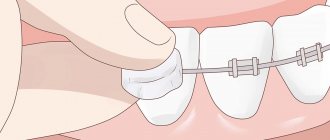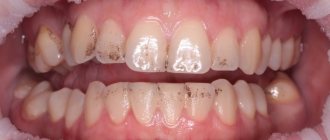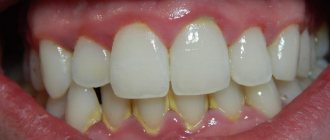Completely removable dentures are used for prosthetics of jaws that are completely devoid of teeth (in the case of edentia). The prosthesis is held on the jaw due to its tight fit to the tissues of the prosthetic bed. If we are talking about a prosthesis for the upper jaw, then high-quality fixation can be achieved through a special valve that creates negative pressure, that is, in essence, the prosthesis is held in place by vacuum. Traditionally, dentures for the lower jaw are very uncomfortable, this is due to poor conditions for their reliable fixation. Specially developed adhesive pastes and creams can help keep the prosthesis in place; they significantly improve the retention (fit) of the structure. Often, such dentures are made of acrylic plastic, with the help of special dyes, it is given the color and shade of the patient’s gums so that it does not stand out against the background of the oral cavity, and artificial teeth are mounted into it, which exactly imitate a person’s normal bite.
The process of getting used to dentures (full or partial) is often long and difficult
Thanks to such products, patients can enjoy life again, eat whatever they want (and even what they could not afford before), since chewing function is completely restored. Without the use of this type of prosthesis, you can forget about normal trips to catering establishments or family feasts, since such a person will not be able to afford anything other than yogurt or puree.
But the question arises - how to get used to dentures ? The process of getting used to removable dentures is very long and often difficult. Such prosthetics cannot be called a complete procedure, since the oral mucosa is constantly irritated, and the patient himself experiences discomfort.
Indications for installation
Plastic dentures are necessary to replace all the teeth in the mouth or some of the lost elements.
Indications for installation:
- Complete absence of teeth. In this case, the structure will be attached to the gums due to the vacuum effect. This type of product is called removable suction cup jaws.
- Partial absence of elements. In this case, the devices are attached to the oral cavity using clasps. The structure is supported by its own preserved elements.
- Missing one unit in a row. In this case, dentists advise patients to have a butterfly denture. This system can be used as a temporary replacement for missing teeth until a permanent denture can be made.
Plastic structures are suitable for fixing mobile teeth, masking deformed elements and temporarily replacing missing segments in a row. There are few contraindications for installing plastic structures. The main ones are an allergy to acrylic, a short crown part of the tooth, and various malocclusions.
What to do if the addiction is seriously delayed?
If, over a fairly long period of time, you cannot get used to the prosthesis (that is, to a foreign body in the mouth), then there may be several logical explanations for this problem:
- Jaw atrophy;
- Individual characteristics of the jaw structure of a particular patient;
- Poor fixation of the structure;
The most difficult thing to get used to is the so-called clasp structures, which are based on fastenings made of metal. In addition to mechanical effects, exposed metal parts can also have chemical effects, reacting with the acidic environment of the oral cavity. It is simply impossible to correct such a product on your own, as it is easily damaged. Therefore, if you have the feeling that such a design is rather poorly and unreliably fixed in your mouth, it is better to go to a specialist. If the mobility of the prosthesis inside the oral cavity is due to jaw atrophy, a special ointment for additional fixation can help you.
Types of products
There are several types of systems depending on the production method, the materials used and the method of attachment in the oral cavity.
Structures are made in 2 ways:
- Compression pressing method. Such a product may not be ideally suited to the parameters of the jaw. However, in this case, getting a removable denture is the easiest and fastest way. Disadvantage of the system: long adaptation period, fragility.
- Casting method. With the help of casting, structures that most precisely match the parameters of the jaw are obtained. They imitate the patient’s teeth and gums as accurately as possible.
Based on the method of fastening, plastic products are divided into removable and non-removable. The first type is recommended for complete absence of teeth. Acrylic is usually used to produce a removable jaw.
Partially removable dentures are recommended for patients to temporarily replace elements when installing dentures. Another indication for their installation is partial edentia. Dentists consider plastic structures as a temporary solution to the problem, since the materials used for their production are of low quality and have low performance properties. The procedure allows patients to maintain an attractive appearance until it becomes possible to undergo prosthetics.
Butterfly prosthesis
Dental plastic or acrylic is most often used in the production of dentures. However, other, more modern materials are also used:
- Ethacryl. It has better strength and performance characteristics compared to acrylic.
- Bicryl. It is resistant to mechanical stress. Does not crack or sag when consuming hard foods.
- Ftorax. It is a translucent material that is invisible in the mouth.
- Acree Free. Made from acrylic resins. It is hypoallergenic due to the absence of monomers in its composition.
Choosing the best removable dentures
With complete absence of teeth
Dentists recommend conditionally removable dentures on implants, as they well restore chewing function, evenly distribute the load, preventing bone resorption and provide reliable fixation. However, the cost of such implantation is quite high.
A good option is dentures with suction cups (much cheaper than the previous ones). The selection of material is carried out by the doctor directly in consultation with the patient. Such structures can be removed at night.
We do not recommend considering nylon dentures for completely edentulous patients, because with such structures it is difficult to chew hard food, they do not have the highest suction ability and they are more expensive than plastic dentures.
With partial absence of teeth
In case of partial absence of teeth, clasp dentures are an ideal option. They never fall off, are very similar to your own teeth and evenly distribute the load.
If clasp dentures are too expensive for your pocket, we recommend choosing acrylic products. You can temporarily install a butterfly prosthesis, and then replace it with a permanent orthodontic structure.
Which ones are better to put on the upper and lower jaw?
The upper jaw is better suited for prosthetics, since there is a large palate there. All removable dentures are secured very well. You can choose any suitable option for the upper jaw.
But on the lower jaw, fixation is much worse, because the sublingual space is small. Dentists say that it will not be possible to make an element with good fastening. In addition, the movements of the tongue contribute to the constant slipping of the prosthesis. For the lower jaw, clasp dentures or dentures on implants are usually chosen.
Prosthesis manufacturing technology
Before installing the prosthesis, the doctor examines the patient’s oral cavity and identifies any contraindications to the procedure. After this, the person is sent for an x-ray to identify the location of the roots of the remaining teeth. Those elements that cannot be restored using conservative techniques must be removed.
Prosthetics are not performed even if there are tumor-like formations in the soft tissues of the mouth. Procedures are prescribed only after removal of the seal (alveolectomy).
The production of a removable denture from acrylic plastic occurs in several stages:
- Grinding of supporting teeth. The procedure helps prevent negative consequences associated with contact between enamel and plastic. The duration of the work ranges from 40 minutes to 3 hours, depending on the specifics of the procedure.
- The dentist takes an impression of the patient’s teeth and sends it to the laboratory for further fabrication of structures. The height of the bite is determined using wax rollers for 15-20 minutes.
- In the laboratory, a wax model of future dentures with artificial teeth implanted into it is recreated.
- After making the model, the orthopedist tries it on the patient's jaw.
- At the last stage, a plastic denture is made. After installation in the oral cavity, the structure is polished and ground. The color of the enamel is selected by the doctor during the clinical stages of treatment.
The injection molding method and pressing have similarities in preparatory activities. In each case, a preliminary formation of a three-dimensional model of the patient’s oral cavity occurs.
For better fixation of the product in the oral cavity, patients are recommended to use special glue. The substances are used once a day: they are applied in a thin layer to the surface of the material in those places where it comes into contact with the gums. At night, the product is removed, and the remaining adhesive is removed.
The choice of a suitable composition is important for reliable fixation of the structure. The degree of patient comfort when wearing a prosthesis depends on the correct decision. Before giving preference to one or another product, you need to pay attention to the following nuances:
- The glue must retain its effect for at least 12 hours. Otherwise, the application procedure will have to be repeated several times a day.
- The paste should be of medium consistency. Liquid glue will spread over the denture, and solid glue will be noticeable in the oral cavity when you smile.
- Preference is given only to pharmaceutical products. Adhesive obtained from hand can cause swelling and redness of the soft tissues of the mouth.
List of popular denture creams:
- Protefix;
- Lakalut;
- Corega.
Popular adhesive for dentures
What problems may arise after installing a denture?
Adaptation to a removable denture begins almost immediately after installation is completed in the dentist's office. And, according to statistics, almost every patient experiences certain difficulties that are associated with the adaptation period. Here are some of them:
- Vomiting reflex . Constant vomiting is a completely normal reaction of the body to a foreign object in the oral cavity, so there is no need to worry too much about this. But there is a category of people who take the longest to get used to dentures, or who don’t get used to them at all. The installation of products that stick to the sky is contraindicated for them. This must be taken into account when choosing a prosthetic method. Often, this problem goes away on its own. But for patients with hypersensitivity, it is better to abandon such structures altogether.
- Profuse salivation . The human body perceives the prosthesis as food, as a result of which the brain sends signals that then activate the corresponding functions, namely the secretion of saliva and gastric juice.
- Unpleasant sensations while eating . First of all, this problem affects the owners of removable dentures; the load is unevenly distributed across the jaw, in contrast to the natural chewing of food with real teeth. It takes a long time to get used to this.
- Perception of taste . You may partially lose your sense of taste, since not only the tongue (as many believe), but also the rest of the oral cavity is involved in its perception. The patient may stop feeling spicy, salty, hot or sweet foods; this process occurs differently for everyone.
- Distortion of speech . The prosthesis and its protruding parts can interfere with the tongue; a person with an installed prosthesis has difficulty pronouncing words. But after some time (about a week), diction returns to normal.
Pros and cons of dentures
Among the positive characteristics of plastic dentures, the following should be noted:
- accessibility to wide sections of the population;
- colorlessness, making dentures similar to natural teeth;
- invisibility of the product while smiling;
- speed of production in contrast to metal-ceramics;
- Possibility of installation in 1 visit to the dentist;
- the ability to select a design of any color, shape and size.
Which dentures are best for teeth?
Like other dental structures, plastic dentures have their disadvantages:
- short service life (less than 5 years);
- the likelihood of developing allergic reactions to acrylic;
- the appearance of bad breath due to insufficient care of the structure;
- the possibility of damage to the soft tissues of the mouth due to the large area of contact of the prosthesis with the palate;
- loss of taste of consumed products due to the product blocking taste buds;
- inability to chew hard foods;
- the need for constant visits to the doctor to assess the condition of the prosthesis.
Due to the porous structure, the color of the prosthesis may change, so when wearing it, it is better to avoid coloring products (juices, soda, coffee, tea), so that the material retains its appearance for as long as possible, it is necessary to give preference to high-quality metal-plastic.
Acrylic dentures
Removable dentures made of acrylic are widely used and are very popular. They can be used for partial or even complete loss of teeth. They are recommended in cases where there is a sufficiently large gap where there are no teeth.
Advantages of acrylic base:
- Almost complete absence of contraindications;
- Suitable both as a temporary option and as a permanent one;
- Fastening with hooks avoids grinding down adjacent teeth;
- Many shades, which means the color of artificial teeth will not differ from real ones;
- Suitable for people of different ages;
- They have a reasonable price.
Acrylic dentures are pleasant and easy to use. Some experts even recommend installing them for children before their molars appear. This will help avoid malocclusion.
Despite the huge number of advantages, this type of prosthesis also has disadvantages. Acrylic structures are quite fragile, although they can last up to 8 years. It will take some time to get used to, this is also a disadvantage of this method. However, the quite affordable price of acrylic structures makes this option accessible to most patients, and therefore very popular.
Product care
To increase the life of artificial teeth, you need to follow certain rules for caring for them. It is important to clean the structure from food debris and plaque in a timely manner to prevent bad breath and the development of dental diseases. Patients wearing plastic prostheses must:
- Clean the product daily using a brush and paste;
- after eating, remove the device from the mouth and rinse under running water;
- do not remove the structure at night during adaptation;
- do not store artificial teeth without a special solution;
- For care, use special tablets and pastes.
Cleaning the prosthesis
Terms of adaptation
For some, the feeling of discomfort passes quite quickly; for others, the adaptation process is inevitably associated with prolonged physical suffering.
Talking about exact dates is quite problematic, because quite a few factors play a role here. For example, the condition of the patient’s gums at the time of installation of the prosthesis. Severely damaged gums will begin to actively rub against the surface of the product, this will cause even greater irritation. In this case, the adaptation process will drag on for several months. The period of adaptation increases significantly when installing clasp dentures; this type of construction has many metal parts that easily damage the soft tissues of the oral cavity.
Psychological state is an important factor in the process of getting used to dentures. A person who experiences stress, is constantly nervous and tries to remove the prosthesis at the first opportunity, himself prolongs the adaptation period, and quite significantly.
If we talk about averages, then for most patients the adaptation period takes approximately two (2) weeks . The reasons listed above can guarantee to increase the period of adaptation to several months.
Question-answer section
What is the maximum service life of dentures?
Experts say that the average service life of the device is 3 years, but with good care you can increase the service life to 5 years. If there is even the slightest damage to the plastic, you should immediately contact the clinic for restoration work.
Removable teeth are also sent for repair if the functionality of the locks is impaired or the initial shape of the arch changes. The price for repairing the product depends on the complexity of the dental work and the size of the structure.
Why does plastic turn dark?
The problem occurs due to the roughness of the material. The porous structure is maintained even after polishing and grinding the linings. Because of this, food and dye residues accumulate on the surface of the prosthesis. Structures lose their original appearance due to plaque.
How to whiten a denture?
The removable jaw is effectively cleaned using abrasive compounds. To do this, you can use special powders or regular baking soda. The procedure should not be repeated too often, as the abrasive components leave small scratches on the product. Because of this, even more plaque accumulates on their surface.
How to clean dentures?
Pharmacies sell many products designed for cleaning and whitening removable jaws. They are usually sold in tablet form to be dissolved in water. The product is immersed in a disinfectant liquid overnight. The most popular manufacturers of tablets for cleaning dentures: Dental, White, Corega, President. Such cleansing is carried out once every 7 days. The procedure gives the structures their original appearance and prevents the proliferation of pathogenic bacteria on their surface.
How is professional whitening of artificial teeth performed?
If home care methods for the device do not produce results, you should contact the clinic for a professional cleaning procedure. This service is provided by almost all dental institutions. In a clinical setting, the prosthesis is polished to reduce contamination later.
How much does a nylon prosthesis cost?
Each clinic providing dental services and dental prosthetics has its own pricing policy. Nylon flexible prostheses, the price of which may please some and upset others, are becoming more popular day by day. But before installing them, it is recommended that you familiarize yourself with the prices, because each dental clinic has their own. The final cost of dentures depends on various factors.
For example, on the condition of the oral cavity, on the number of missing teeth, on the location of the clinic and its reputation. The skill of a specialist plays an important role in pricing, and the higher the professional rating, the more expensive the doctor’s services. In any case, the installation of such orthodontic structures will cost much less than implantation and prosthetics with zirconium crowns.
Nylon dentures, the cost of which is affordable, for many people are the only opportunity to fill gaps in the dentition, and without significant financial expenses.
It is worth noting the fact that structures are not always fixed using soft clasps, since they can be metal. This is a cost-reducing factor, but the fact is that metal clasps are too noticeable and there can be no talk of any aesthetics. Therefore, before giving them preference, you should think carefully: is such saving necessary that it worsens aesthetic characteristics? There is an opinion that “hard fixation” is more reliable, but in fact, this assumption is not true, since soft clasps also perform their task well.
Patient reviews
Oksana, Tver. The doctor recommended prosthetics with plastic structures to me after I lost 1 tooth, visible when I smile. There was no money for implantation, so I was recommended an alternative way to restore a lost tooth - a butterfly denture. The cost of the design is only 15,000 rubles. The product is invisible when worn. At night, remove the structure and clean it with a brush and special paste. People around me don’t notice that one of my teeth is not real.
Kostya, Samara. Since I was young I have had problems with my teeth and regularly see the dentist. After the teeth began to loosen, the doctor suggested installing a self-adhesive plastic denture. At first it was unusual to talk and eat solid food, so I took all meals only in crushed form. I was able to return to my previous diet after 3 weeks.
Anton, Perm. After a maxillofacial injury, my 3 front teeth were removed. This situation caused my discomfort in front of others. After some hesitation I made a choice in favor of a plastic bridge. The product was manufactured in a short time, but after its installation I felt significant discomfort while talking and eating. Another unpleasant problem was that the prosthesis constantly rubbed the gums. I had to go back to the clinic to have the product corrected. It’s been 2 years now and now I wear the prosthesis regularly, taking it off only at night. I don’t feel the same discomfort from wearing it.
Which dentures are better: nylon or acrylic?
Having decided to get dentures, many people ask the question: which removable dentures are best? Which material to choose: nylon or acrylic? There is no clear answer to this question. It all depends on your needs and individual characteristics. A lot also depends on your finances.
Nylon dentures are suitable for people with allergies, but acrylic ones are not the best option in this case. When trying on, pay attention to your own feelings. Prosthetic materials are perceived differently by each person. If the prosthesis causes discomfort when trying on, then when worn every day this can become a problem. Be careful and consult your doctor. This will help avoid discomfort when wearing.
From a financial point of view, acrylic structures are much more affordable than nylon ones. However, nylon ones are more comfortable to wear; acrylic ones are considered a temporary option before dental implantation.
Taking into account many aspects and the authoritative opinion of the dentist, you can choose the most suitable prosthetic option. Therefore, choosing the best removable denture is a purely individual matter.











